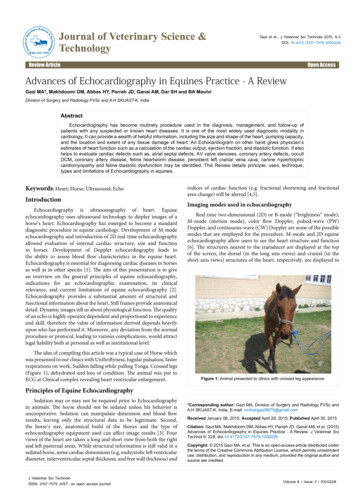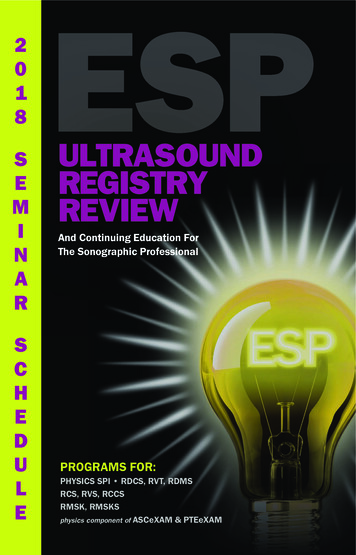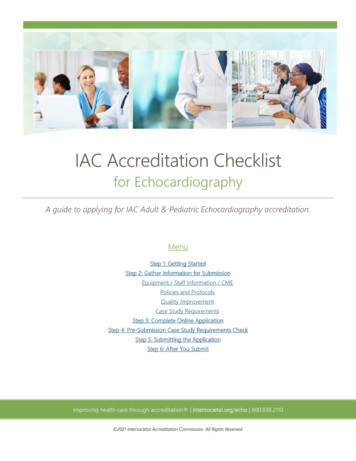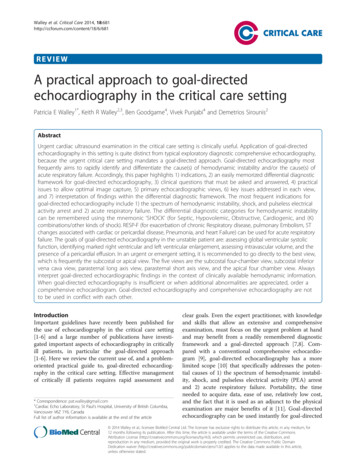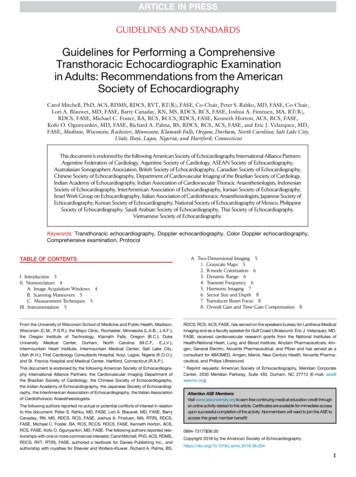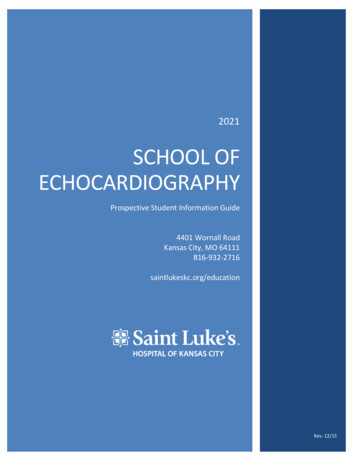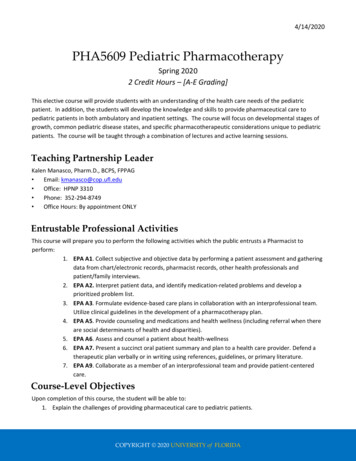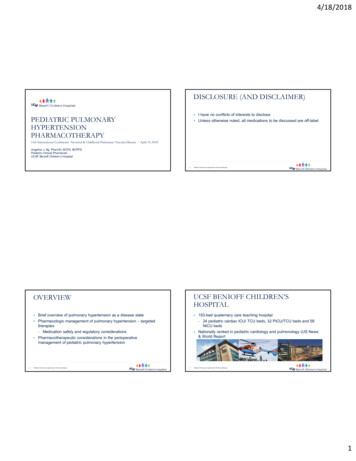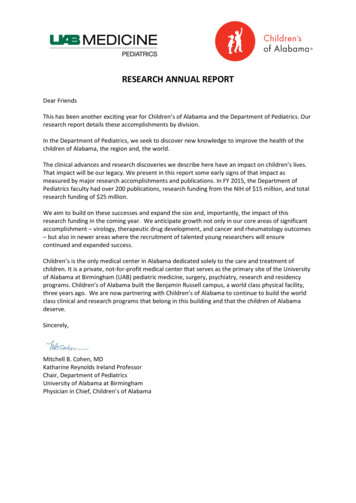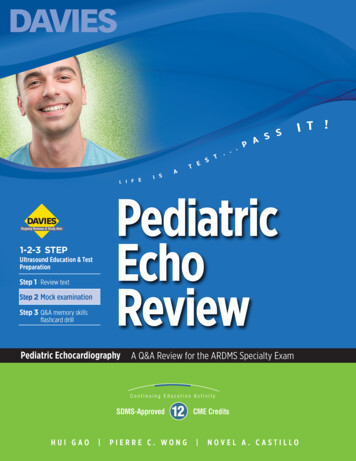
Transcription
Pediatric Echocardiography ReviewA Q&A REVIEW FOR THE ARDMS PEDIATRIC ECHOCARDIOGRAPHY EXAMHui Gao, MB, RDCS (AE, FEc, PE)Children’s Hospital Los AngelesLos Angeles, CaliforniaPierre C. Wong, MDChildren’s Hospital Los AngelesLos Angeles, CaliforniaNovel A. Castillo, RDCS (AE, FEc, PE)Children’s Hospital Los AngelesLos Angeles, CaliforniaDAVIESPUBLISHING
Copyright 2020 by Davies Publishing, Inc.DAVIESPUBLISHINGAll rights reserved. No part of this work may be reproduced, stored in a retrievalsystem, or transmitted in any form or by any means, electronic or mechanical,including photocopying, scanning, and recording, without prior written permission from the publisher. If you receive a photocopy or web-based copy of this orany other Davies book, please call toll-free to report it—1-877-792-0005 duringbusiness hours, 9am–5pm Pacific time. Thank you!Davies Publishing, Inc.32 South Raymond AvenuePasadena, California 91105-1961Phone 626-792-3046Facsimile 626-792-5308e-mail ichael P. Davies, PublisherChristina J. Moose, Editorial DirectorCharlene Locke, Production ManagerJanet Heard, Operations ManagerSatori Design Group, Inc., DesignPrinted and bound in the United States of America.ISBN 978-0-941022-18-7Library of Congress Cataloging-in-Publication DataNames: Gao, Hui, 1963- author. Wong, Pierre C., author. Castillo, NovelA. (Novel Amilcar), 1979- author.Title: Pediatric echocardiography review : a Q&A review for the ARDMSpediatric echocardiography exam / Hui Gao, Pierre C. Wong, Novel A.Castillo.Description: Pasadena, California : Davies Publishing, Inc., 2020. Includes bibliographical references and index. Summary: “PediatricEchocardiography Review is a mock examination consisting of more than600 multiple-choice questions, answers, explanatory text, and referencesdesigned to aid students and clinicians taking the ARDMS Pediatric Echoregistry exam. It is designed to improve both knowledge and test-takingskills, covering the material on the ARDMS exam content outline for thePediatric Echocardiography specialty exam in effect as of 2019. Coverspediatric cardiac anatomy and physiology, pathology and pathophysiology,congenital anomalies, postoperative anatomy, clinical standards andguidelines, and measurement techniques and quantification. This mockexam is also approved by the Society of Diagnostic Medical Sonography asa continuing medical education activity worth 12 credit hours”-Provided by publisher.Identifiers: LCCN 2019033416 ISBN 9780941022187 (paperback)Subjects: MESH: Echocardiography--methods Child Infant Adolescent Examination QuestionClassification: LCC RC683.5.U5 NLM WG 18.2 DDC 616.1/207543076--dc23LC record available at https://lccn.loc.gov/2019033416
ReviewersRuben J. Acherman, MDJoseph Daniel, BS, RDCS (AE, PE)Professor of PediatricsUniversity of Nevada Las VegasDirector of Fetal Cardiology ProgramChildren’s Heart Center NevadaLas Vegas, NevadaCardiac Sonographer IIChildren’s Hospital Los AngelesLos Angeles, CaliforniaFariborz Behzadian, MD, RDCS (AE, PE,FEc), RVTPediatric Cardiac SonographerChildren’s Hospital Los AngelesLos Angeles, CaliforniaLouis I. Bezold, MDProfessor of PediatricsDivision Chief of Pediatric CardiologyKentucky Children’s HospitalUniversity of Kentucky College of MedicineLexington, KentuckyAarti H. Bhat, MD, FASE, FACCAssociate ProfessorDirector, Heart Center Quality ImprovementPediatric CardiologySeattle Children’s HospitalUniversity of WashingtonSeattle, WashingtonXiaoling Cao, MB, RDCS (AE, PE)Senior Cardiac SonographerHeart and Vascular InstituteHoag Memorial HospitalNewport Beach, CaliforniaIAC Technical DirectorHeart Services Echocardiography LaboratoryCHOC Children’s HospitalOrange, CaliforniaAndrew L. Cheng, MD, FAAP, FACCAttending Physician, Division of PediatricCardiologyChildren’s Hospital Los AngelesAssistant Professor of Clinical PediatricsKeck School of Medicine, University ofSouthern CaliforniaLos Angeles, CaliforniaJohn Ho, MDPediatric CardiologistPacific Pediatric Cardiology Medical GroupPasadena, CaliforniaKristin Kennedy, RDCS (AE, PE)Staff SonographerLucile Packard Children’s Hospital StanfordStanford, CaliforniaFrederic J. Leong, MD, FACCPediatric CardiologistPediatric Cardiology Medical AssociatesThousand Oaks, CaliforniaKatie Jo Stauffer, BS, RDCS (AE, PE, FEc),FASELead Pediatric Cardiac SonographerLucile Packard Children’s Hospital StanfordStanford Children’s HealthPalo Alto, CaliforniaXiaohong Su, RDCS (AE, PE, FEc)Echo Tech IIBoston Children’s HospitalBoston, MassachusettsAdam Sutherland, RDCS (AE, PE), RVTPediatric Cardiac SonographerChildren’s Hospital Los AngelesLos Angeles, CaliforniaShuo (Sue) Wang, MDPediatric Cardiology Advanced Imaging FellowChildren’s Hospital Los AngelesLos Angeles, CaliforniaYin Tao Wang, MB, RDCS (AE, PE, FEc)Technical Director, Pediatric EchocardiographyLabPediatric CardiologySanger Heart & Vascular InstituteCharlotte, North Carolinav
PrefaceT HIS MOCK EXAM is a question/answer/reference review of Pediatric Echocardiographyfor those candidates who plan to take the PE specialty examination for the RegisteredDiagnostic Cardiac Sonographer (RDCS) credential administered by the AmericanRegistry for Diagnostic Medical Sonography (ARDMS). Those sitting for the Registered CardiacSonographer (RCS) exam administered by Cardiac Credentialing International (CCI) will likewisefind that these items will bolster and solidify their preparation. Designed as an adjunct to yourregular study, this mock exam will help you precisely determine your strengths and weaknessesso that you can study more effectively. This mock exam is also an SDMS-approved CME activityworth 12 credits (see Part 8).Facts about Pediatric Echocardiography Review4 This mock exam covers the material on the ARDMS exam content outline in effect as of2019–2020. Readers are advised to check the ARDMS website, www.ardms.org, for thelatest updates. The mock exam itself is continuously updated and revised as necessary,and readers can check Davies’ website for the latest Study Alerts and other productupdates by visiting 20.aspx.4 The mock exam focuses exclusively on the Pediatric Echocardiography (PE) specialty examto ensure thorough coverage of even the smallest subtopic and clinical task on the exam.(For those preparing for the Sonography Principles and Instrumentation exam, see Davies’Ultrasound Physics Review: SPI Edition, available in either print or interactive format atwww.daviespublishing.com.)4 We use the most current ARDMS content outline as a guideline for coverage. It is, in fact,the foundation for our table of contents.4 This mock exam contains 603 questions, many of which are accompanied by sonographicand other images, anatomic illustrations, and schematics—more than 150 image-basedcases. More than 60 of these are real-time video clips accessible by registering your bookwith Davies at our website.4 Items are presented in ARDMS exam format to give you an educational tool that will exercisethose neural pathways in more than one direction. Registry candidates who master theseitems at an average rate of 1 minute apiece will be exceptionally well prepared for theactual exam.4 The answer key located in Part 7 contains not only the answers but also concise explanations that are abundant, clear, and authoritatively referenced for further study. We recommend that you have a copy of a standard pediatric echocardiography review text at yourside when using this mock exam to study for the PE exam—you will see several of thesereferenced in both the answer section and the “Suggested Readings” in Part 9.vii
viii Pediatric Echocardiography Review4 This mock examination has been approved by the Society of Diagnostic Medical Sonography(SDMS) as a CME activity. A CME application form, quiz, and full submission instructionsare included in Part 8. Passing this quiz will qualify the applicant for 12 CME credits. Amodest administrative processing fee applies at the time of submission, and more thanone sonographer may use the forms in this book to submit this activity for CME credit.These credits are accepted by ARDMS, APCA, CCI, the American Registry of RadiologicTechnologists (ARRT), and other organizations toward meeting their CME requirements.Some credentials carry stipulations regarding specialty areas in which CME credits may beearned. Always check with the organization that governs your credential(s). All the creditsin this activity may be applied to maintain the ARDMS RDCS credential.4 The expanded ARDMS exam content outline, complete with all questions that apply tospecific clinical tasks, appears in Part 10. Under each task we have indexed the questionnumbers in this mock exam that are related to that task, for your convenience in targetingyour study on specific exam topics. (To ensure that your study is targeted at the mostcurrent examination outline, be sure to visit the ARDMS website at www.ardms.org.)ARDMS Advanced Item Type (AIT) QuestionsAll the ARDMS exams now include Advanced Item Type (AIT) questions that assess practicalinstrumentation skills. For the PE specialty exam, these AIT questions include what ARDMS calls“Hotspot” questions. Hotspot items display an image with the question and ask you to indicatethe correct answer by marking directly on the image using your cursor; this type of questionis called “advanced” because it involves a higher level of thinking and processing than youperform when answering a conventional multiple-choice question. In Davies’ mock exam, similarquestions are identified as “AIT—Hotspot” questions. These items ask you to identify what anarrow in the image is pointing at or to indicate the label on an image that corresponds to thecorrect answer.Another type of AIT question, the Semi-Interactive Console (SIC) item, requires the examinee touse a semi-interactive console to correct a problem with the image presented. Currently theseitems do not appear on the PE exam, but as a bonus feature we have identified such items as“AIT—SIC” questions.Finally, PACSim items—case-based Picture Archive and Communication Simulation questions—arenot included in this mock exam because currently this type of question is specifically designed forand limited to the Physician in Vascular Interpretation (PVI) and the Ob/Gyn exams—the formerunder the jurisdiction of the Alliance for Physician Certification and Advancement (APCA).How to Use This Mock ExamPediatric Echocardiography Review effectively simulates the content of the Pediatric Echocardiography (PE) exam. Current ARDMS standards call for 150 multiple-choice questions to beanswered during a three-hour period. That is, you will have an average time of approximatelyone minute to answer each question. Timing your practice sessions according to the numberof questions you need to finish will help you prepare for the pressure experienced by PE candidates taking this exam. It also helps to ensure that your practice scores accurately reflect yourstrengths and weaknesses so that you can study more efficiently in the limited time you are ableto devote to preparation.
Pediatric Echocardiography Review ixImportant note: Although many of our customers remark on similarities between our questionsand those of the actual exam, do not be misled into thinking you should memorize these questions and answers. They are here to give you practice, to teach you things you may not know,and to reveal your strengths and weaknesses so that you know where to put your energy as youprepare for the exam. They also provide a means of assessing your progress as you study.ARDMS test results are reported as a “scaled” score that ranges from a minimum of 300 to amaximum of 700. A scaled score of 555 is the passing score—the “passpoint” or “cutoff score”for all ARDMS examinations. The scaled score is simply a conversion of the number of correctanswers that also, in part, takes into account the difficulty of a particular question. You cansearch on the Internet for the “Angoff scoring method” if you want to learn more about scaledscoring. Suffice it to say that it helps to ensure the fairness of the exams.We include below and strongly recommend that you read Taking and Passing Your Exam, by DonRidgway, RVT, who offers useful tips and practical strategies for taking and passing the ARDMSexaminations.Finally, you have not only our best wishes for success but also our admiration for taking this bigand important step in your career.Hui GaoHui Gao, MB, RDCSPierre C. WongPierre C. Wong, MDNovel A. CastilloNovel A. Castillo, RDCS
ContentsReviewers vPreface viiTaking and Passing Your Exam xColor Plates xxiiiPART 1Anatomy and Physiology 1PART 2Pathology and Pathophysiology 19PART 3Congenital Anomalies 39PART 4Postoperative Anatomy 85PART 5Clinical Standards and Guidelines 123PART 6Measurement Techniques and Quantification 139PART 7Answers, Explanations, and References 175PART 8Application for CME Credit 427PART 9Suggested Readings 463PART 10ARDMS Exam Content Outline: Tasks Cross-Referencedto Mock Exam Questions 465xiii
PART 1Anatomy and Physiology1
Pediatric Echocardiography Review Refer to video PER-Q28.928. The patient in this video clip has transposition of thegreat arteries (d-TGA). Which anatomic structure is thearrow pointing to?A. Single left coronary arteryB. Circumflex from the right coronary arteryC. Conal branch off the right coronary arteryD. Posterior descending coronary arteryAIT—Hotspot29. In this image, which aortic anatomic structure is thearrow pointing to?A. Left coronary cusp (LCC)B. Right coronary cusp (RCC)C. Right and left commissural postD. Noncoronary cusp (NCC)AIT—Hotspot30. Which of these imaging methods, when paired with 2Dimaging, helps locate the origins of the coronary artery?A. Spectral DopplerB. Power DopplerC. Color flow DopplerD. M-mode31. Left main coronary artery filling is best seen during:A. DiastoleB. Aortic valve openingC. Mitral valve closureD. Systole
10 Pediatric Echocardiography Review32. This image demonstrates the right coronary artery(arrow) filling during which phase of the cardiac cycle?See Color Plate 1on page xv.A. Isovolumic relaxationB. Early diastolic fillingC. Late diastolic filling (atrial contraction)D. SystoleAIT—Hotspot33. The arrow in this image is pointing to the:A. Left atriumB. Coronary sinusC. Thebesian valveD. Circumflex coronary arteryAIT—Hotspot
Pediatric Echocardiography Review 1134. In this image, what vascular structure is the arrowpointing to?See Color Plate 2on page xv.PVAVLAALACSA. Left superior vena cavaB. Subclavian veinC. Azygos veinD. Hemiazygos veinAIT—Hotspot35. In this image, what vascular structure is the arrowpointing to?Right superiorvena cavaA. External jugular veinB. Innominate veinC. High intercostal veinD. Innominate arteryAIT—HotspotAorta
12 Pediatric Echocardiography Review36. Which anatomic structure is best visualized from theapical four-chamber view with posterior angulation ofthe transducer?A. Superior vena cavaB. Circumflex coronary arteryC. Left anterior descending coronary arteryD. Coronary sinus37. During embryologic development, the left horn of thesinus venosus eventually develops into which structureof the normal four-chambered heart?A. Eustachian valveB. Coronary sinusC. Levoatrial cardinal veinD. Superior vena cava38. During embryologic development, the right horn of thesinus venosus eventually develops into which structureof the normal four-chambered heart?A. Left atriumB. Pulmonary veinsC. Right atriumD. Left atrial appendage39. Which structure is the arrow in this image pointing to?A. Coumadin ridgeB. Thebesian valveC. Eustachian valveD. Crista terminalisAIT—Hotspot
Pediatric Echocardiography Review 1340. Azygos continuation of the inferior vena cava (IVC)occurs when there is:A. Interruption of the hepatic portion of the IVCB. Interruption of the left vitelline veinC. Interruption of the levoatrial cardinal veinD. Interruption of the right anterior cardinal vein41. You are scanning a newborn baby. You start with yoursubcostal views and pulsed-wave Doppler evaluation ofthe abdominal aorta and find prominent diastolic flowreversal. What do you suspect you will encounter duringthe remainder of the exam?A. Significant coarctation of the aorta (CoA)B. Unicuspid aortic valve with severe stenosisC. Bicuspid aortic valve (BAV) with mild stenosisD. Patent ductus arteriosus (PDA)42. You are performing echocardiography on a patient in theneonatal intensive care unit and note a right-sided aorticarch with an aberrant left subclavian artery. Which ofthe following options would result in a vascular ring?A. A patent ductus arteriosus on the same side as theaortic archB. A right-sided patent ductus arteriosusC. A left-sided patent ductus arteriosusD. A patent ductus arteriosus originating from the leftinnominate artery43. Left atrial morphology is best established by which ofthe following characteristics?A. Site of pulmonary venous connectionB. Crista terminalisC. Finger-like appendageD. Septum secundum44. Which situs of the abdominal viscera is characterized bya right-sided liver, left-sided stomach, left-sided spleen,and right-sided cecum?A. Situs totalisB. Situs inversusC. Situs ambiguusD. Situs solitus
PART 7Answers, Explanations,and ReferencesAnatomy and physiologyPathology and pathophysiologyCongenital anomaliesPostoperative anatomyClinical standards and guidelinesMeasurement techniques and quantification175
188 Pediatric Echocardiography Review30. C. Color flow Doppler.Coronary artery imaging is one of the most challenging partsof echocardiographic evaluation, and one should use allthe appropriate tools available. The use of 2D imaging andcolor flow Doppler imaging in combination is the best way toidentify coronary artery origins.4Lai WW, Mertens LL, Cohen MS, et al (eds): Echocardiography in PediatricANSWERSand Congenital Heart Disease: From Fetus to Adult, 2nd edition. Chichester,UK, Wiley-Blackwell, 2016, p 587.31. A. Diastole.Left main coronary artery filling occurs primarily duringdiastole.4Lai WW, Mertens LL, Cohen MS, et al (eds): Echocardiography in Pediatricand Congenital Heart Disease: From Fetus to Adult, 2nd edition. Chichester,UK, Wiley-Blackwell, 2016, p 586.32. D. Systole.See Color Plate 1on page xv.The image shows the right coronary artery (top arrow) filling during systole. The lower arrow marks the point on theelectrocardiographic tracing when the image was frozen.According to Lai et al., compressive forces exerted by theright ventricle are ordinarily less than those of the left ventricle; therefore, coronary blood flow to the right ventricle is notinterrupted during ventricular systole.4Lai WW, Mertens LL, Cohen MS, et al (eds): Echocardiography in Pediatricand Congenital Heart Disease: From Fetus to Adult, 2nd edition. Chichester,UK, Wiley-Blackwell, 2016, p 586.
Pediatric Echocardiography Review 189The coronary sinus (arrow) is a posterior structure that can beseen as it drains into the leftward and inferior portion of theright atrium. Additional views to evaluate the coronary sinusare the parasternal long-axis view, with a tilt toward the righthip to visualize the right ventricular inflow, and a subcostallong-axis (four-chamber) view, with posterior angulation.4Lai WW, Mertens LL, Cohen MS, et al (eds): Echocardiography in Pediatricand Congenital Heart Disease: From Fetus to Adult, 2nd edition. Chichester,UK, Wiley-Blackwell, 2016, pp 47–51.34. A. Left superior vena cava.See Color Plate 2on page xv.PVAVLAALACSWhen a left superior vena cava (LSVC) is present, it usuallyconnects to the coronary sinus (CS). In such cases, the CSwill be dilated compared to its usual size when an LSVC is notpresent. Therefore, a clue to a persistent LSVC is a dilatedCS. A bridging vein (innominate vein) is usually absent, butrarely it can remain present, connecting right and left SVCs.ANSWERS33. B. Coronary sinus.
190 Pediatric Echocardiography ReviewWhen a bridging vein is present, its caliber can vary in sizebut is usually small. When an LSVC is present, care shouldalso be taken to rule out partial pulmonary venous drainageto an LSVC. Color flow imaging and a spectral Doppler profileaid in identifying anomalous pulmonary venous drainage to anLSVC. Other possible reasons for a dilated CS include hepaticANSWERSveins draining into the CS, total anomalous pulmonary venousconnection (TAPVC) to the CS, or CS ostial stenosis. Arrow left superior vena cava, CS coronary sinus, PV pulmonaryvalve, AV aortic valve, LAA left atrial appendage, and LA left atrium.4Lai WW, Mertens LL, Cohen MS, et al (eds): Echocardiography in Pediatricand Congenital Heart Disease: From Fetus to Adult, 2nd edition. Chichester,UK, Wiley-Blackwell, 2016, pp 160–166, 182–186.35. B. Innominate vein.Right superiorvena cavaAortaThis image shows the innominate, or brachiocephalic, vein(arrow) in the suprasternal short-axis view. This view wasobtained with the transducer in the suprasternal notch withthe index marker positioned at 3 o’clock. An additional view tovisualize the innominate vein can be acquired with the transducer in the suprasternal notch with the index marker positioned at 1–2 o’clock. In this view you will see the innominatevein superior to the aortic arch.4Lai WW, Mertens LL, Cohen MS, et al (eds): Echocardiography in Pediatricand Congenital Heart Disease: From Fetus to Adult, 2nd edition. Chichester,UK, Wiley-Blackwell, 2016, pp 54, 56, 184.
Pediatric Echocardiography Review 19136. D. Coronary sinus.The coronary sinus (CS) is a posterior structure and can bevisualized by a posterior angulation of the transducer in theapical four-chamber view. In this view, the CS can be seenperpendicular to the angle of insonation, returning to the rightatrium.and Congenital Heart Disease: From Fetus to Adult, 2nd edition. Chichester,UK, Wiley-Blackwell, 2016, p 49.37. B. Coronary sinus.The left horn of the sinus venosus eventually develops into thecoronary sinus. The Eustachian valve is a remnant of the rightvalve of the sinus venosus. The superior vena cava is derivedfrom the right anterior cardinal vein. The levoatrial cardinalvein is not present in the normal four-chambered heart; whenpresent, it is frequently seen in association with hypoplasticleft heart syndrome and a restrictive atrial septum.4Lai WW, Mertens LL, Cohen MS, et al (eds): Echocardiography in Pediatricand Congenital Heart Disease: From Fetus to Adult, 2nd edition. Chichester,UK, Wiley-Blackwell, 2016, p 185.4Moore KL, Persaud TVN, Torchia MG: The Developing Human: ClinicallyOriented Embryology, 9th edition. Philadelphia, Elsevier Saunders, 2013,pp 292, 305–306.38. C. Right atrium.In normal heart development the right horn of the sinusvenosus eventually becomes the smooth-walled portion of theright atrium. The pulmonary veins are derived from a commonpulmonary vein arising from the primitive lung buds, and thiscommon pulmonary vein eventually forms a portion of the leftatrium in conjunction with the embryonic left atrium of theprimitive heart tube. The left atrial appendage also derivesfrom the embryonic left atrium.4Moore KL, Persaud TVN, Torchia MG: The Developing Human: ClinicallyOriented Embryology, 9th edition. Philadelphia, Elsevier Saunders, 2013,pp 150, 204, 210, 305–306.ANSWERS4Lai WW, Mertens LL, Cohen MS, et al (eds): Echocardiography in Pediatric
192 Pediatric Echocardiography ReviewANSWERS39. C. Eustachian valve.The valve of the inferior vena cava is the Eustachian valve(arrow). Care must be taken to clearly identify this structurebecause in the setting of an atrial septal defect (ASD) theEustachian valve can wrongly be identified as an inferior rimof the defect. This is important in the setting of an ASD deviceclosure as well as surgical closure of an ASD.4Lai WW, Mertens LL, Cohen MS, et al (eds): Echocardiography in Pediatricand Congenital Heart Disease: From Fetus to Adult, 2nd edition. Chichester,UK, Wiley-Blackwell, 2016, pp 207–210, 240.40. A. Interruption of the hepatic portion of the IVC.Interruption of the hepatic portion of the inferior vena cava(IVC) does not mean that all components that form theIVC are missing; only the hepatic segment of the IVC is notpresent. Study of the embryologic venous system can enhanceunderstanding of hepatic duplication of the inferior vena cava,interruption of the hepatic segment of the IVC, and othersystemic venous malformations.4Lai WW, Mertens LL, Cohen MS, et al (eds): Echocardiography in Pediatricand Congenital Heart Disease: From Fetus to Adult, 2nd edition. Chichester,UK, Wiley-Blackwell, 2016, p 181.4Moore KL, Persaud TVN, Torchia MG: The Developing Human: ClinicallyOriented Embryology, 9th edition. Philadelphia, Elsevier Saunders, 2013,pp 292, 295.41. D. Patent ductus arteriosus (PDA).A moderate to large sized patent ductus arteriosus (PDA) willgenerally be associated with prominent reversal of flow withinthe abdominal aorta. Other examples of cardiac pathology
Pediatric Echocardiography Review 193that can present with prominent diastolic flow reversal includesignificant aortic regurgitation, aortico–left ventricular tunnel(ALVT), and sinus of Valsalva rupture.4Lai WW, Mertens LL, Cohen MS, et al (eds): Echocardiography in Pediatric42. C. A left-sided patent ductus arteriosus.As a rule of thumb, the aortic arch, descending aorta, andductus arteriosus should all be on the same side to excludea vascular ring. Special care must be taken when imaginga right-sided aortic arch, an aberrant left subclavian artery,and a left-sided ductus arteriosus (originating from the leftsubclavian artery or a diverticulum of Kommerell), whichcan be a setup for a vascular ring. One exception to thisstatement would be a right-sided aortic arch and a left-sidedpatent ductus arteriosus originating from the left innominate(brachiocephalic) artery. In choice D, the patent ductusarteriosus is too far anterior to cause a vascular ring.4Allen HD, Driscoll DJ, Shaddy RE, et al: Moss and Adams’ Heart Diseasein Infants, Children, and Adolescents: Including the Fetus and Young Adult,8th edition. Philadelphia, Lippincott Williams & Wilkins, 2013, pp 758–788.43. C. Finger-like appendage.Hallmarks of left atrial morphology include a finger-like atrialappendage and the flap valve of the foramen ovale (atrialseptum primum). The crista terminalis and septum secundumare characteristics of the morphologic right atrium; thesestructures cannot be readily visualized on transthoracicechocardiography. The site of pulmonary venous connection isnot a reliable marker of left atrial morphology.4Anderson RH, Baker EJ, Penny D, et al: Paediatric Cardiology, 3rd edition.Philadelphia, Churchill Livingstone/Elsevier, 2010, p 21.4Lai WW, Mertens LL, Cohen MS, et al (eds): Echocardiography in Pediatricand Congenital Heart Disease: From Fetus to Adult, 2nd edition. Chichester,UK, Wiley-Blackwell, 2016, pp 35–37.44. D. Situs solitus.A right-sided liver, left-sided stomach, left-sided spleen,and right-sided cecum are all typical of normally positionedabdominal viscera, or situs solitus.4Lai WW, Mertens LL, Cohen MS, et al (eds): Echocardiography in Pediatricand Congenital Heart Disease: From Fetus to Adult, 2nd edition. Chichester,UK, Wiley-Blackwell, 2016, pp 33–35.ANSWERSand Congenital Heart Disease: From Fetus to Adult, 2nd edition. Chichester,UK, Wiley-Blackwell, 2016, pp 83, 320, 350.
Pediatric Echocardiography Review effectively simulates the content of the Pediatric Echocar-diography (PE) exam. Current ARDMS standards call for 150 multiple-choice questions to be answered during a three-hour period. That is, you will have an average time of approximately one minute to answer each question.
